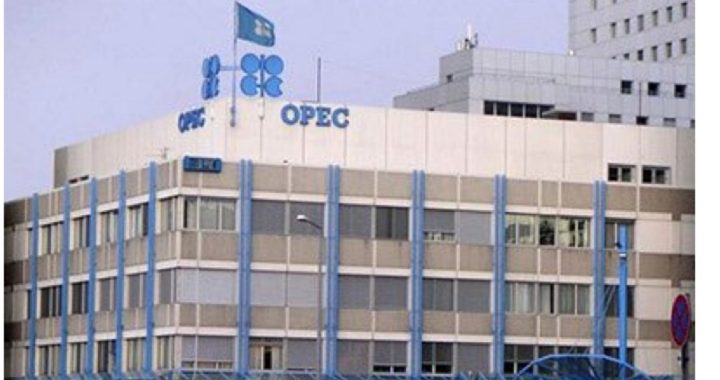
Following a contentious six-hour meeting on Friday, OPEC oil ministers meeting in Vienna announced that nothing will change: They will continue to pump at maximum rates despite the growing glut of oil in the world. Predictably, crude oil prices dropped, along with wholesale gasoline prices.
The fragile cartel’s members are pumping close to 31.5 mbd (million barrels per day) and would pump more if they could. They are already above the mythical “ceiling” of 30 mbd. When Iran, which currently provides 2.7 mbd to that number, recovers from U.S.-imposed sanctions, it expects to pump four mbd by next summer, adding further downside pressure on crude oil prices.
At these prices nearly every barrel OPEC members sell to the world market is sold at a loss. But the ministers are persuaded that, with the rig count dropping precipitously in the United States, eventually production will drop enough to “balance the market,” allowing prices to rise back to profitability for OPEC. The ministers are also gambling that a recovering world economy will generate additional demand. If so, then — voila! — prices will rise and the game of chicken will be over. OPEC wins; United States loses.
A closer look at the underlying economic and supply/demand numbers reveals something vastly different. OPEC faces a “conundrum,” according to the Wall Street Journal: If they continue to pump flat out, crude prices will fall further, costing them more dearly as they drain not only their crude reserves but their foreign currency reserves as well to keep their welfare states afloat. But if they cut production, and prices start to rise, those idle rigs in the United States will come on stream in short order, putting a ceiling on just how high crude prices might rise.
As recently as April, Venezuela’s economy was characterized as being “devastated” by low oil prices, with the country’s bonds pricing in a default. Its foreign currency reserves had dwindled to $20 billion, a level so low that the government has refused to provide investors with current data. Estimates are that inflation in Venezuela, thanks to money printing to pay the government’s bills, is running 100 percent a year.
Before Friday’s meeting Venezuela’s oil minister, Eulogio Del Pino, said that if OPEC continues to pump at maximum rates, oil could fall further, to $20 a barrel, adding “The overproduction we have from OPEC is going to produce a catastrophe in the price.”
In the novel The Hunt for Red October, the U.S. captain of a submarine running at maximum speed into the path of an oncoming Russian torpedo, put it this way: “The trouble with a game of chicken is knowing when to duck.”
At present, low oil prices are helping the American consumer. Gasoline prices over Thanksgiving were the lowest since 2008, averaging now less than $2.00 a gallon, with some locales enjoying prices below $1.70 a gallon.
Part of OPEC’s gamble is their expectation that U.S. oil production will drop as marginal producers leave the market either through bankruptcy or merger. So far, according to the U.S. Energy Information Administration (EIA), production has dropped just three percent since April. Producers continue to find ways to generate additional production out of existing wells.
And there’s another factor OPEC is ignoring: The survivors will be even stronger competitors. Charles Perry, the CEO of energy consulting firm Perry Management, said that all OPEC’s strategy “does is eliminate the weaker oil producers via bankruptcy and consolidation with the stronger companies. OPEC has not figured out that the survivors will be much stronger competitors.”
OPEC may be losing its other bet as well: that increasing global demand for crude next year will put in a bottom in oil’s price, and push its price higher. There are at least three things that could be wrong with that assumption: China, Latin America, and emerging economies.
As the International Monetary Fund (IMF) wrote a month ago,
China’s rebalancing is generating large spillovers, and notwithstanding the Chinese economy’s sizeable buffers, could be disruptive abroad. Either a moderate slowdown or a harder landing over the medium term could produce sizeable spillovers via slower global trade, and further weakening of commodity prices, and confidence effects.
Latin America’s economies, according to banking giant UBS, are estimated to shrink again in 2015, “marking the worst recession since the 2008 financial crisis and the greatest underperformance relative to the rest of the world in almost 30 years.”
Overall, according to the IMF, economies in emerging countries will decline in 2015 for the fifth year in a row. Russia’s is expected to decline 3.8 percent this year, while Brazil’s is expected to shrink by 3.8 percent.
One persuasive indicator that suggests that OPEC’s game of chicken is going to go against them is the Baltic Dry Index (BDI), an economic indicator that measures the cost of moving raw materials by sea. The BDI peaked in December 2013 at 2,330. On Friday the BDI was 563, a breathtaking drop of 75 percent in less than two years.
There was a time when OPEC dictated to the world what the price of oil would be. Thanks for free markets and technological advances, those days are over.
A graduate of an Ivy League school and a former investment advisor, Bob is a regular contributor to The New American magazine and blogs frequently at LightFromTheRight.com, primarily on economics and politics. He can be reached at [email protected].



